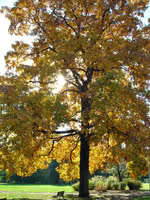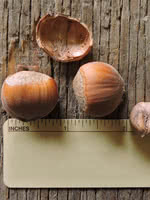Mon-Fri 9am - 5pm Mountain time
Shagbark Hickory vs Aldara Hazelnut
Carya ovata
Corylus heterophylla Het 3
NOT AVAILABLE THIS SEASON - MIGHT RETURN
Shagbark Hickory is a unique tree both for its looks and uses. Its bark peels into long thin vertical strips giving it a shaggy appearance. This and its golden fall leaves make it a gorgeous looking tree. This species produces tasty hickory nuts once mature. Hickory smoke is also treasured for curing meats and its generally fantastic smell.
This tree is best planted away from any buildings due to a deep taproot and large size. Many people remark on the unusual taproot for this tree that can be over 6 feet deep while the plant only has 2 feet of top growth.
Aldara Hazelnut is a northern hybrid selection noted for its superior nut quality, disease resistance, and cold hardiness.
It is great for attracting wildlife with the added bonus of edible nuts that can be eaten fresh or used in baking. Pair with another Aldara or Andrew Hazelnut for cross pollination to occur.
Aldara and Andrew Hazelnut are currently the hardiest and most reliable nut varieties available for the Canadian prairies.
Note: You want more than one hazelnut to improve yields.

